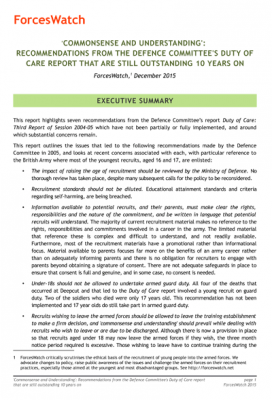‘Commonsense and Understanding’: Recommendations from the Defence Committee’s Duty of Care report that are still outstanding 10 years on

This report highlights seven recommendations from the Defence Committee’s report Duty of Care: Third Report of Session 2004-05 which have not been partially or fully implemented, and around which substantial concerns remain.
The report outlines the issues that led to the following recommendations made by the Defence Committee in 2005, and looks at recent concerns associated with each, with particular reference to the British Army where most of the youngest recruits, aged 16 and 17, are enlisted:
- The impact of raising the age of recruitment should be reviewed by the Ministry of Defence. No thorough review has taken place, despite many subsequent calls for the policy to be reconsidered.
- Recruitment standards should not be diluted. Educational attainment standards and criteria regarding self-harming, are being breached.
- Information available to potential recruits, and their parents, must make clear the rights, responsibilities and the nature of the commitment, and be written in language that potential recruits will understand. The majority of current recruitment material makes no reference to the rights, responsibilities and commitments involved in a career in the army. The limited material that reference these is complex and difficult to understand, and not readily available. Furthermore, most of the recruitment materials have a promotional rather than informational focus. Material available to parents focuses far more on the benefits of an army career rather than on adequately informing parents and there is no obligation for recruiters to engage with parents beyond obtaining a signature of consent. There are not adequate safeguards in place to ensure that consent is full and genuine, and in some case, no consent is needed.
- Under-18s should not be allowed to undertake armed guard duty. All four of the deaths that occurred at Deepcut and that led to the Duty of Care report involved a young recruit on guard duty. Two of the soldiers who died were only 17 years old. This recommendation has not been implemented and 17 year olds do still take part in armed guard duty.
- Recruits wishing to leave the armed forces should be allowed to leave the training establishment to make a firm decision, and ‘commonsense and understanding’ should prevail while dealing with recruits who wish to leave or are due to be discharged. Although there is now a provision in place so that recruits aged under 18 may now leave the armed forces if they wish, the three month notice period required is excessive. Those wishing to leave have to continue training during the notice period and there is evidence that pressure is put on them to remain. Under-18s are still required to serve out their sentences for AWOL or other offences.
- The Ministry of Defence should collect data about the socio-economic background of recruits, and about incidences of bullying, and research the impact of socio-economic background on subsequent careers. Concerns remain about the lack of data collected by the MoD on the socio-economic background of recruits and incidences of bullying and assault.
This report goes on to present additional evidence and arguments about the experience of the youngest recruits including:
- Lower educational standards within the armed forces.
- Evidence that the youngest recruits are subject to higher physical and mental health risks, than older recruits, including self-harm and bullying; and have poorer long-term outcomes.
- Understanding that adolescence is a period of on-going maturation and vulnerability, and how the practices and process by which young people are recruited into the armed forces are likely to have ill effects.
This report then discusses the concept of ‘in loco parentis’ and ‘moral obligation’ with regard to the army’s duty of care towards young recruits, noting that the Defence Committee were concerned in 2005 that the MoD distinguished too rigidly between legal and moral obligations, with the latter as less important. The MoD give greater recognition to their duties as employers under the Health and Safety at Work Act 1974 than to the more comprehensive demands of the Children’s Act 1989. One important example of this is the failure to ensure that all staff at training establishments have DBS checks.
In 2005, the Defence Committee discussed the lack of balance beween training needs and considerations for operational effectiveness, and thus made its recommendations. Ten years on, it is apparent that operational arguments, and current difficulties meeting recruiting targets, continue to prevent the armed forces from reviewing both their position on enlisting under-18s, and their recruitment practices and materials.
Raising the age of recruitment would prioritise the best interest of young people recruited in the armed forces, who would benefit from recruits who are more mature and do not need additional duty of care requirments. They would be deployable straight after training and there would be significant financial savings, as under-18s cost more to train and have a high drop out rate. Recruits who still wished to join could enlist at 18, in line with the growing international concensus around the age at which it is appropriate to become involved in preparation for armed conflict.
ForcesWatch recommends that:
- The manner in which the armed forces meet their recruitment needs must not jeopardise the best interests of young people, and that the recruitment of under-18s should stop.
- That the Defence Committee commission thorough, independent review of the policy of recruiting 16 and 17 year olds into the armed forces.
- That the other Duty of Care report recommendations discussed here are implemented without further delay and that the MoD report to the Defence Committee on their progress in implementing them.
- That the Defence Committee review the Duty of Care report and request that the MoD account for its implementation or otherwise of all remaining recommendations.
